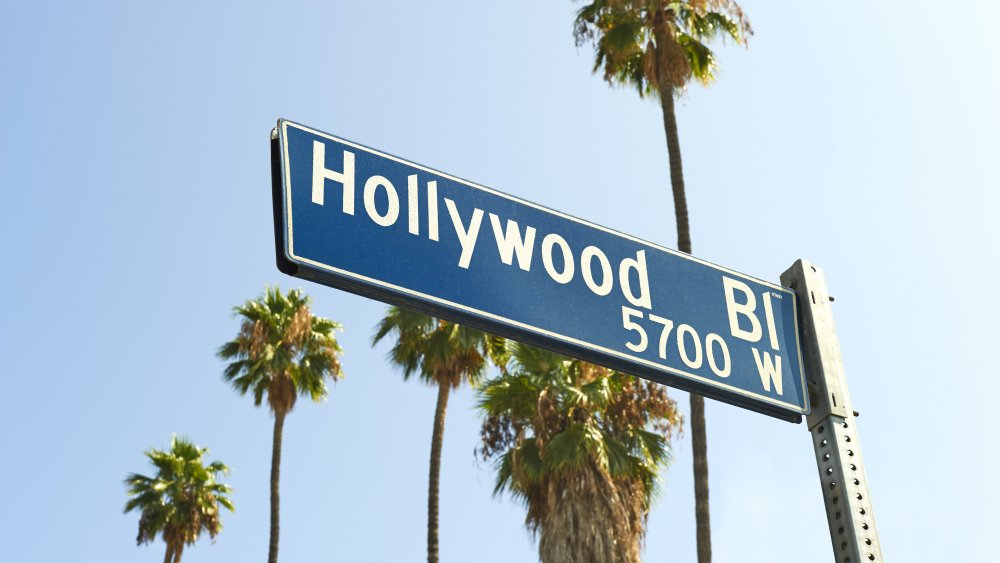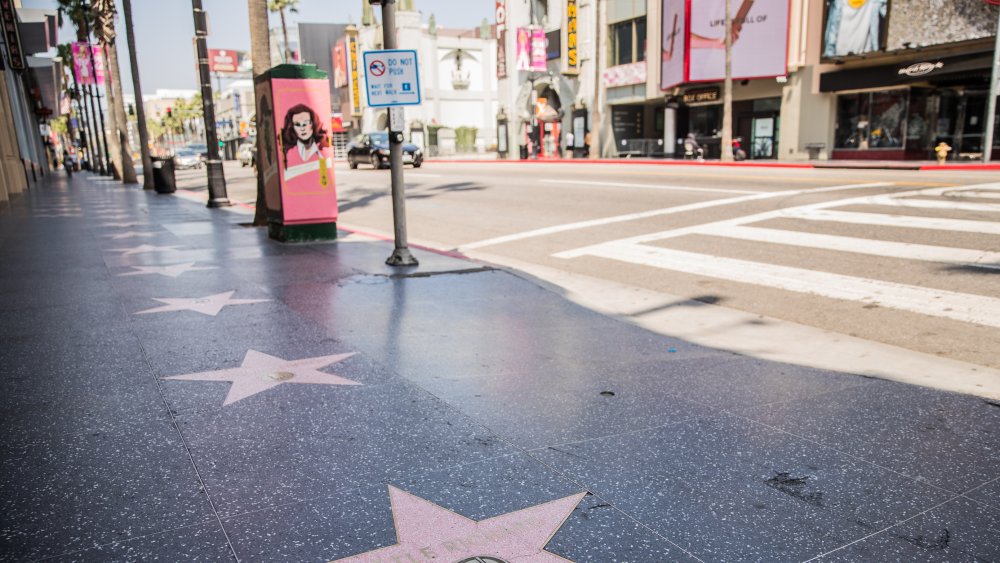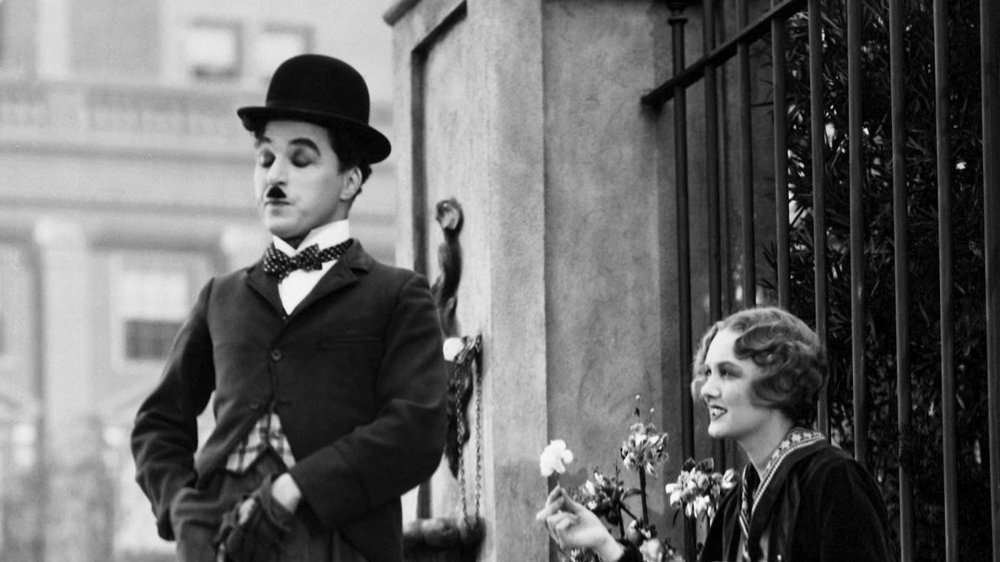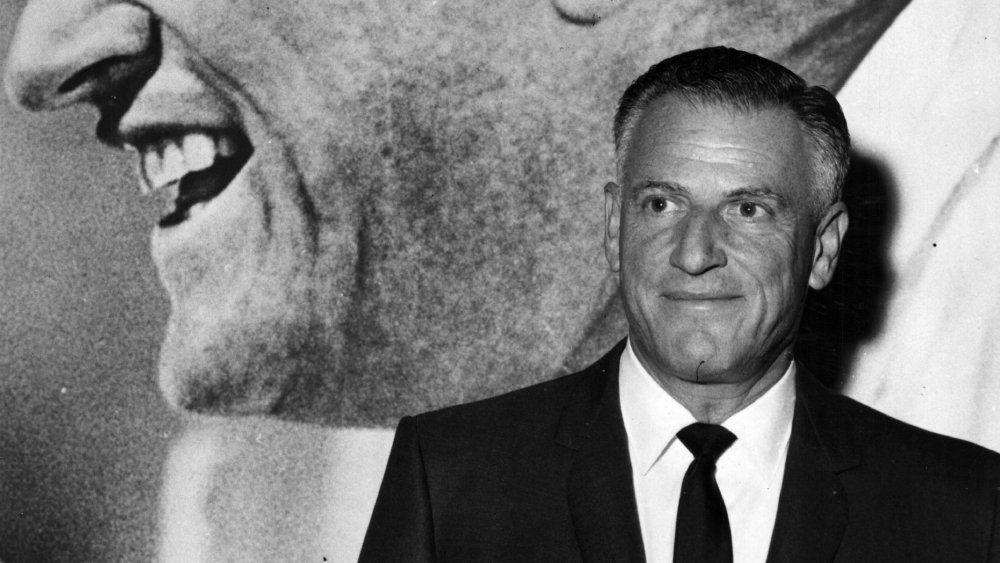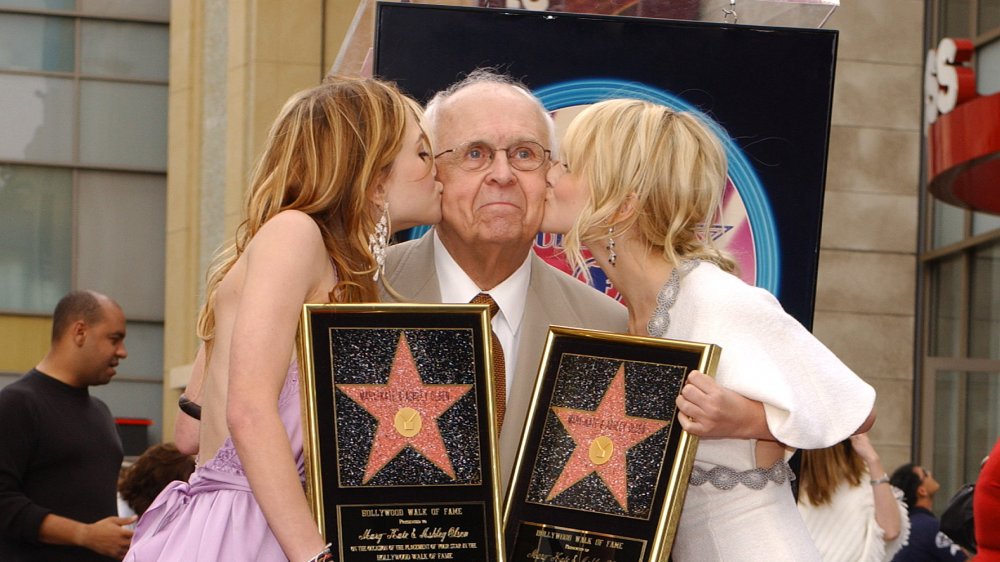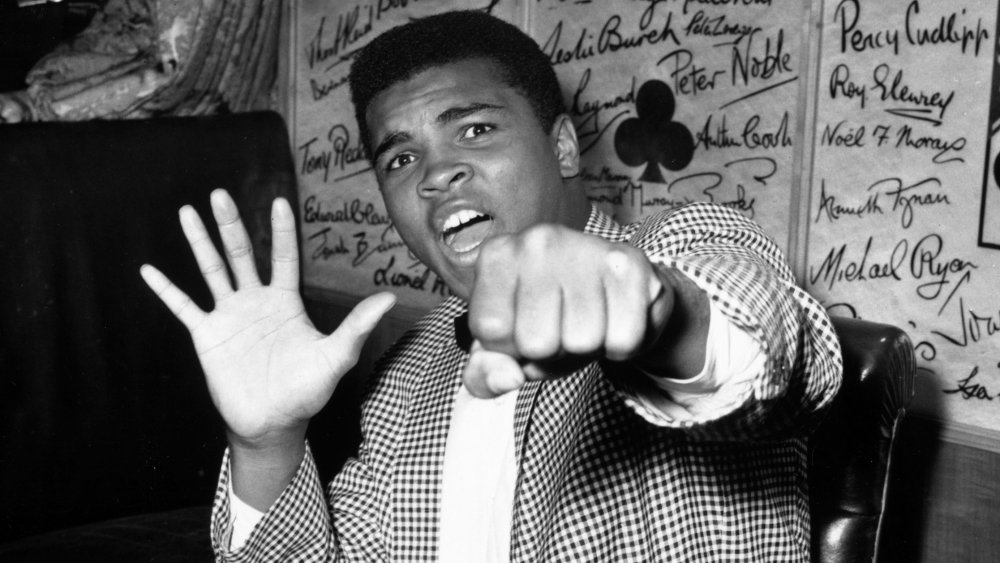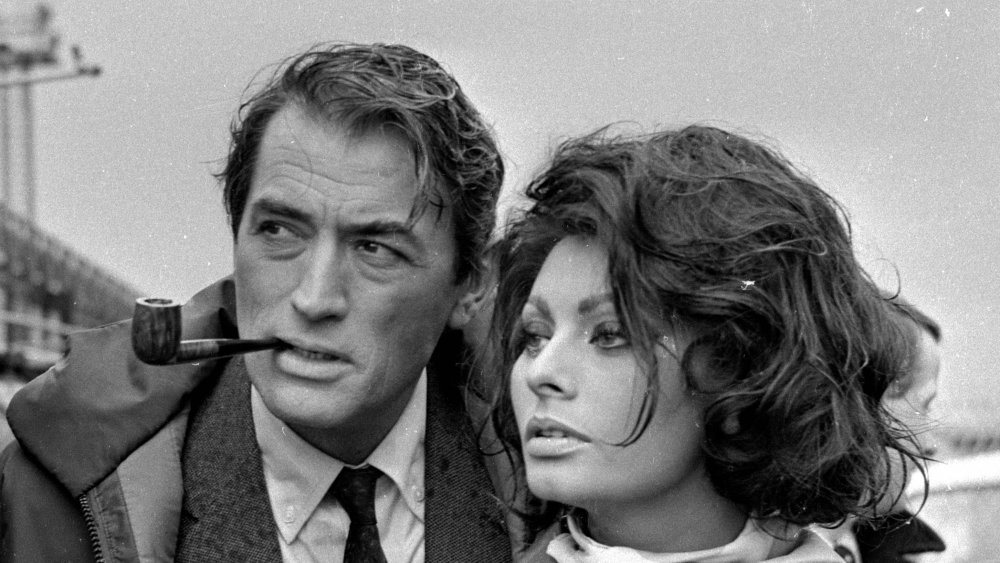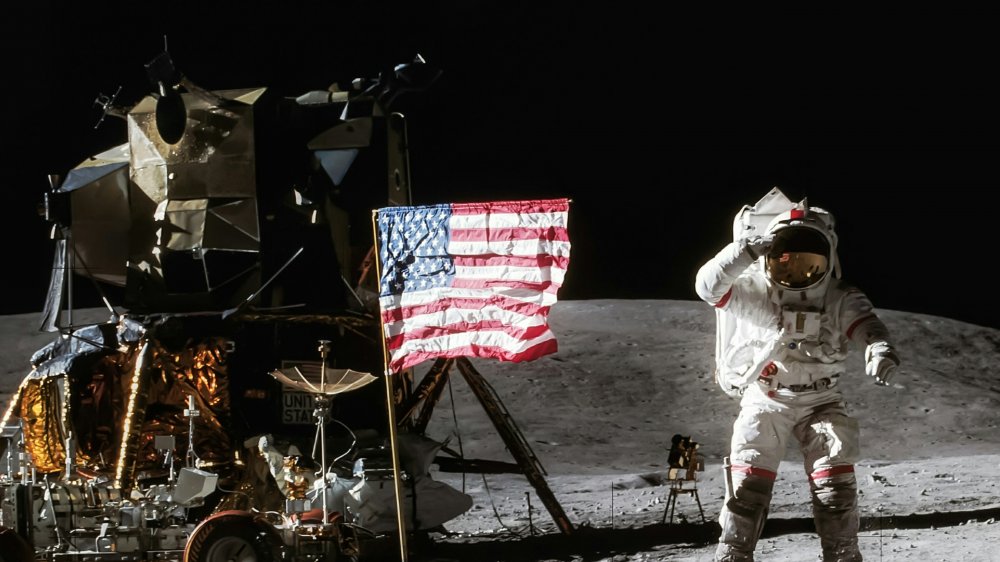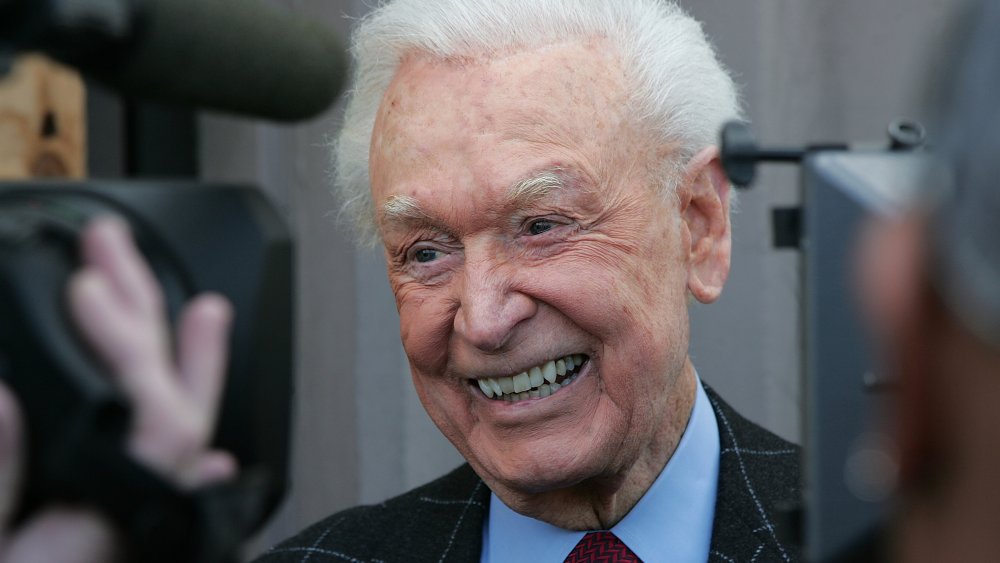The History Of The Hollywood Walk Of Fame Explained
It's perhaps the most famous sidewalk in the world, and nearly ten million people come to visit it each year. But not many know the true history of the Hollywood Walk of Fame. Since 1960, thousands of terrazzo stars have been cemented in history along Hollywood Boulevard and Vine Street by the world's most famous entertainers. The ceremonies honoring inductees have become a Hollywood tradition, and according to the official Hollywood Walk of Fame website, around 24 induction ceremonies are held each year.
The LA Times writes that the Hollywood Walk of Fame was developed in the 1950s "by business leaders in Hollywood as a way to beautify the area's historic core." But the history of the star-studded sidewalk hasn't always been pretty. Over the years, some very strange things have happened, from lawsuits delaying construction of the initial project to stars being stolen or removed. And many people you'd never imagine — both athletes and astronauts — have been honored with stars. The iconic sidewalk has some very interesting tales to be told, so here's the history of the Hollywood Walk of Fame explained.
The Hollywood Walk of Fame begins
According to Walk of Fame, in 1953, E.M. Stuart, volunteer president of the Hollywood Chamber of Commerce, came up with the idea for the Hollywood Walk of Fame. Stuart's intention was to "maintain the glory of a community whose name means glamour and excitement in the four corners of the world." Stuart established a committee and appointed architectural firm Periera and Luckman to develop proposals. Some say Stuart may have gotten his idea from the ceiling of the dining room of the historic Hollywood Hotel, which once had stars and the names of celebrities painted on it.
In 1955, the proposal's tenets were agreed upon, which allowed the Hollywood Chamber of Commerce "to present to the City for further action in the formation of an assessment district," writes Walk of Fame. In 1956, the plans were submitted to the Los Angeles City Council, which then instructed the Board of Public Works to take the next important steps by making the engineering specifications. They also needed to create the necessary assessment district that would be in charge of paying for improvements.
The Hollywood Walk of Fame could have been brown and blue
In 1956, a mockup of the stars, which would have featured caricatures of the honorees, was proposed, writes Walk of Fame. Believe it or not, the original design for the Hollywood Walk of Fame had blue and brown tiles. The committee soon realized that the caricatures would be too hard to develop, and the color scheme was soon changed, as well. Hollywood businessman C.E. Toberman had a new building being developed on the same street, and the brown and blue colors wouldn't have matched, so the sidewalk tiles were changed to coral and black.
Eventually, the Hollywood Improvement Association was created to work with the city in pursuit of the project and was led by another big Hollywood businessman, Harry Sugarman. Sugarman was dedicated to the project and oversaw it to its completion. He came from a family of film exhibitors and owned one of California's oldest theaters. There would soon be more changes made during the following year that would add more star power to the project.
The Hollywood Walk of Fame is first represented by four entertainment committees
Between 1956 and 1957, four committees were created to represent motion pictures, television, recording, and radio, according to Walk of Fame. Each committee included the most powerful names in their industries. For example, 500 stars were chosen as the first inductees, and 150 of them were chosen by the Motion Picture Selection Committee. Cecil B. DeMille, Samuel Goldwyn, Jesse Lasky, Daily Variety editor Joe Schoenfeld, Walt Disney, Hal Roach, Mack Sennett, and Walter Lantz were just some of the big names involved in selecting honorees. It wasn't until 1984 that Theatre/Live Performance was added as another aspect of entertainment and another committee was created, reports Mental Floss.
Eventually, the city finalized plans for the assessment district, which cost $1.25 million: This worked out to $85 per front foot, which was paid for by adjacent property owners. The following year, the public would finally get to see what the Hollywood Walk of Fame would look like.
Eight honorees' stars are unveiled on the Hollywood Walk of Fame
In 1958, eight stars were celebrated as honorees for the Hollywood Walk of Fame: Olive Borden, Ronald Colman, Louise Fazenda, Preston Foster, Burt Lancaster, Edward Sedgwick, Ernest Torrence, and Joanne Woodward, per Walk of Fame. The public and investors were now able to get an idea of how it would look, which created much more excitement before construction began. However, the project was delayed because of two pending lawsuits.
The first lawsuit was filed by nearby property owners who didn't like the $1.25 million tax assessment that came with the Walk's construction, writes Mental Floss. The second lawsuit was filed by Charlie Chaplin, Jr. who asked for $400,000 in damages because his father wasn't chosen to be inducted as one of the original honorees. A judge ruled against the property owners, and Chaplin's case was dismissed. However, Charlie Chaplin was eventually honored for all his legendary work. In 1972, he got a star on the Hollywood Walk of Fame and received an honorary Oscar.
The first official star is placed on the Hollywood Walk of Fame
On March 28, 1960, film producer and director Stanley Kramer was the first honoree to have his star officially placed on the Hollywood Walk of Fame, close to the intersection of Hollywood and Gower, writes Walk of Fame. Stanley Kramer was a suitable first choice, given his lengthy and important list of achievements in the industry. According to Britannica, Kramer's films helped spark the careers of actors such as Kirk Douglas and Marlon Brando, and he worked with Katharine Hepburn, Jack Benny, Sidney Poitier, Tony Curtis, Cary Grant, Humphrey Bogart, and Dr. Seuss. He directed classics such as The Defiant Ones and It's a Mad, Mad, Mad, Mad, World. Kramer also received Academy Award nominations for his directing, and in 1961, he received the Irving G. Thalberg Memorial Award from the Academy of Motion Picture Arts and Sciences for the "consistently high quality" of his films.
Even though Kramer was honored, the Hollywood Walk of Fame still wasn't finished. E.M. Stuart was appointed chair of the Completion Committee and created a ceremony to mark the completion of the project. The job was finally finished in spring 1961, when it was finally accepted by the Board of Public Works, and consisted of 1,558 stars at the time.
How stars are honored on the Hollywood Walk of Fame
Celebrities don't buy their stars on the Hollywood Walk of Fame. They must be nominated. According to the LA Times, anyone, even a fan, can nominate a candidate — the only catch is that the celebrity must agree. According to Variety, this is a policy named after Bruce Springsteen, who turned down his star after being nominated by fans and chosen by a committee. Clint Eastwood also declined to have a star after receiving a nomination from fans. Celebrities must sign a form promising they'll be there to accept the star. Those who've passed away can also get a star on the Hollywood Walk of Fame. Per the LA Times, "Posthumous nominations are accepted no sooner than five years after a person's death and only one posthumous award is granted annually."
If the honoree signs a confirmation form, there is a $50,000 sponsorship fee donated to the Hollywood Historic Trust, "a nonprofit organization that oversees the maintenance of the street and handles repairs that cannot be afforded by the city," as stated by Variety. The fee pays for the creation and installation of the star, as well as the ceremony and a plaque. The nomination of an applicant can be carried over for the following cycle if they aren't selected the first time.
Johnny Grant is made chairman of the Hollywood Walk of Fame Committee
For many years, there was a man who was associated with the Hollywood Walk of Fame the same way you'd associate Michael Jordan with basketball. Entertainer and host Johnny Grant was a staple of the Hollywood Walk of Fame ceremonies, writes Walk of Fame. In 1980, Grant was honored with a star on the Hollywood Walk of Fame for his work as a television host, sports broadcaster, radio DJ, and telethon fundraiser, among many other achievements, as documented on Grant's official website. Grant became so enthused about the honor of being added to the Hollywood Walk of Fame that he involved himself in creating the most memorable star ceremony possible.
The Chamber was so impressed with his efforts that they approached him about chairing the Walk of Fame Committee. Grant accepted and took the ceremonies to new levels. From then, until his death in January 2008, Johnny's name became synonymous with the Walk of Fame. As chairman, Grant developed a fifth category of "Live Theatre" in 1984. People who rose to fame in all types of live performance could be considered for stars. Grant also figured out how to keep the Hollywood Walk of Fame from running out of space. The project was designed to accommodate only 2,518 stars, so he approved the creation of a second row of stars on the sidewalk, which would alternate with the existing stars.
Muhammad Ali is the only Hollywood Walk of Fame star you can't step on
Once live performances were established for the Hollywood Walk of Fame in 1984, celebrities from all lines of work were being considered as honorees. In 2002, legendary boxer Muhammad Ali was given a star after boxing was considered by the committee as a form of live performance. And if you're hoping to find Ali's star, you won't be able to step on it because it was placed in the wall of the Dolby Theater. His star is also the only star on the Hollywood Walk of Fame you can't step on. According to The Independent, Ali said he didn't want to be walked on by "people who have no respect for me. [...] I bear the name of our Beloved Prophet Mohammad (peace be upon him), and it is impossible that I allow people to trample over his name."
Ali was arguably the most entertaining boxer ever. He was famous for using poetic phrases during interviews and turning boxing matches into events the entire world wanted to watch. The legendary boxer was known for being defiant and taking a stand for his beliefs. According to Britannica, Ali refused to enter the US Army in April 1967, as the Vietnam War raged on, due to his religious convictions. Ali was stripped of his belt, indicted for his refusal, and found guilty. However, his conviction was unanimously overturned by the US Supreme Court on a narrow procedural ground.
450 stars were removed from the Hollywood Walk of Fame
In 1994, according to Mental Floss, 450 stars were removed from the Hollywood Walk of Fame due to construction of two subway stations on Hollywood Boulevard. Elvis Presley, Marilyn Monroe, Walt Disney, Bob Hope, Groucho Marx, Gene Kelly, Ingrid Bergman, Bing Crosby, Judy Garland, Arnold Schwarzenegger, and Charlie Chaplin (who couldn't catch a break getting his star) were some of the celebrities whose stars who had to be removed temporarily.
The Associated Press (via Deseret News) reports that each star weighs around 150 pounds apiece. Crews moved away about ten a night until about a third of the stars on the walk at that time were removed. Cushioned crates were used to move each star, and they wouldn't be returned until 1997, after the construction of the Red Line stations. It was indeed a strange but necessary thing to happen to the Hollywood Walk of Fame.
Four Stars on the Hollywood Walk of Fame were stolen
Gregory Peck, Jimmy Stewart, Kirk Douglas, and Gene Autry have all had their stars stolen from the Hollywood Walk of Fame, as reported by Mental Floss. According to the East Valley Tribune, Gregory Peck's original star was stolen in November 2005 by someone who cut the star from the sidewalk with a cement saw, apparently with no one noticing. Peck's star had been on the Walk of Fame for more than four decades. Johnny Grant proposed a deal with the callous thief, saying: "You know now you can't sell it. This has become a worldwide story and if you'll just bring it back and leave it right here I'll forget the whole thing happened."
Jimmy Stewart's and Kirk Douglas' stars were stolen five years before Peck's after being removed for construction. Their stars were later found by police in suburban South Gate. Gene Autry's star was also stolen during a construction project. Grant said he got a call from someone who said they found the star in Iowa, but it was never returned. Peck got a new star on November 30, 2005. A new ceremony was held for Peck, and his new star was placed back on the Hollywood Walk of Fame.
Who has the most stars on the Walk of Fame?
Across the nearly 2,700 stars on the Hollywood Walk of Fame, some celebrities appear more than once. The LA Times reports that Gene Autry is the only person to be recognized in all five fields: film, TV, radio, live performance, and music. Autry was not only an entertainer but also a businessman. His 1998 obituary said: "He was enormously successful at almost anything he tried — radio, records, songwriting, television, real estate and business, as well as movies and museums."
Bob Hope and Tony Martin both have four stars, while Frank Sinatra, Danny Kaye, and Jack Benny have three. So far, only two women share three stars: Dinah Shore and Gale Storm. Astronauts from the Apollo Moon landing of 1969 also have four stars, though they're actually round and not star-shaped. Each plaque has the names of the three astronauts from the mission: Neil A. Armstrong, Edwin E. "Buzz" Aldrin Jr., and Michael Collins. The LA Times notes that the astronauts are honored in the television category because of the Moon landing being televised and not due to conspiracy theories of the major historic mission taking place in a studio.
A time capsule is placed under the Hollywood Walk of Fame
In the future, hopefully, there will be people who will be able to look back in time and see the significance of the Hollywood Walk of Fame from those who captured pieces of it for them. Mental Floss writes that in 2010, a time capsule was placed under the same spot where the Hollywood Walk of Fame began for its 50th-anniversary celebration.
KNBC reported that the capsule includes items connected with each of the five categories: DVDs of the 1960 and 2010 Oscars will represent the motion picture category, while an invitation, ticket, and program from the 2010 Primetime Emmys will be there for television. The recording category will be represented by a replica of Los Angeles' iconic Capital Records Building, as well as a letter. Radio will be conveyed to the future via a flash drive. Within are shows past and present from Pioneer Broadcasters, in addition to one by Jim Ladd of KLOS-FM (95.5). Finally, playbills from productions of Wicked and The Lion King from the Pantages Theatre will acknowledge live theater.
Original Price is Right host Bob Barker (pictured above) helped bury the capsule full of items that commemorate the Hollywood landmark. The time capsule will be opened in 2060.

